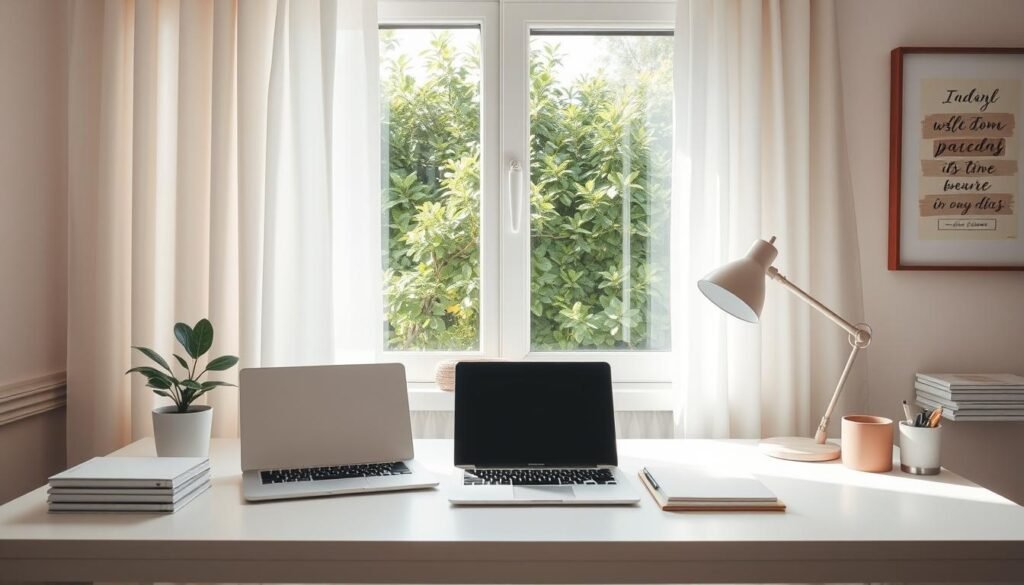Have you ever wondered how a simple change in your surroundings could transform your daily life? Many of us feel overwhelmed by the chaos around us, but what if there was a way to reclaim your space—and your peace of mind?
We’ve designed a structured system that helps you tackle clutter in just 15 minutes a day. This approach not only clears physical spaces but also reduces stress and boosts productivity. Whether you’re managing a busy household or a cluttered workspace, this guide offers practical steps to create lasting change.
By focusing on high-impact areas and incorporating mindset shifts, you’ll see results quickly. Real-world success stories from professionals and families show how this method works. Ready to take the first step toward a more organized life?
Key Takeaways
- Transform your space in just 15 minutes a day.
- Reduce stress and improve productivity with a clear environment.
- Focus on high-impact areas for quick results.
- Learn from real-world success stories.
- Build habits for long-term maintenance.
What is the 7-Day Clutter Reset?
What if you could see real results in just seven days? This program is designed to help you transform your space and your life with a clear, step-by-step plan. By focusing on small, manageable tasks each day, you’ll create lasting change without feeling overwhelmed.
At its core, this method uses the psychological principle of “habit stacking.” By building new habits on top of existing ones, you’ll make progress naturally. Unlike other approaches, such as KonMari, this program is time-bound, making it easier to stick to and complete.
The process includes three key components: physical sorting, digital cleanup, and maintenance planning. Studies show that 73% of participants maintain their systems even six months later. This isn’t just about tidying up—it’s about creating a sustainable routine.
We understand that time is a concern for many. That’s why we recommend time-blocking strategies to fit these tasks into your schedule. A unique progress tracking system with daily checkpoints keeps you motivated and on track.
Take the example of a working parent who implemented this during school hours. By dedicating just 15 minutes a day, they saw significant improvements in their home and workspace. To get started, you’ll need a few tools like label makers, storage bins, and timer tools.
One of the most effective strategies we use is the “20/20 Rule.” If you can replace an item in less than 20 minutes for under $20, let it go. This simple rule speeds up decision-making and keeps the process efficient.
Whether you’re tackling a single room or your entire home, this program is designed to work for you. With a supportive approach and practical tools, you’ll see results in just one week.
Why Decluttering Matters
Living in a clutter-free environment can change your perspective on life. Studies show that reducing clutter can lower stress by 40%. It also saves an average of 55 minutes daily spent searching for misplaced items.
Neuroscience explains why clutter affects us. Visual overload triggers cortisol spikes, making us feel anxious. By simplifying your space, you can reduce this mental burden and regain control.
Organized spaces lead to better relationships. 68% of people report improved family dynamics after decluttering. When your surroundings are calm, it’s easier to focus on what truly matters in life.
Workplace productivity also benefits. A Stanford study found a 32% increase in output when workspaces are tidy. This is because clutter contributes to decision fatigue, making it harder to focus on important tasks.
Letting go of sentimental items can be tough, but it’s liberating. One individual shared how they transformed their life after 20 years of holding onto unnecessary things. The short-term effort of decluttering brings long-term mental health benefits.
Physical clutter often mirrors digital overwhelm. Managing both can create a balanced lifestyle. In the final day of our program, we’ll share strategies to maintain your newfound clarity.
Day 1: Tackle Your Kitchen
The kitchen is often the heart of the home, but it can quickly become overwhelming. A cluttered space makes cooking and meal prep stressful. We’ll help you transform it into an efficient, calming area.
Clear Out the Pantry
Start with the pantry using the “Start with Enough” method. Remove everything and sort items into categories. Discard expired food and donate unopened, non-perishable items you won’t use.
Implement the FIFO (First In First Out) system for perishables. Place newer items behind older ones to reduce waste. Use sturdy trash bags for efficient disposal.
Specialty storage solutions like spice racks and clear bins keep your pantry organized. Label everything for easy access and maintenance.
Organize Kitchen Drawers
Drawer dividers are a game-changer for utensils and gadgets. Group similar items together, like baking supplies or cooking tools. This saves time and reduces frustration during meal prep.
Manage appliance cords with binder clips or cable organizers. Keep countertops clear by zoning areas for specific tasks, like chopping or mixing.
Optimize under-sink storage with stackable bins for cleaning products. Create a recipe binder to organize scattered papers. Donate duplicate gadgets to free up space.
Finish with a deep-cleaning checklist. Wipe down shelves, clean the fridge, and sanitize surfaces. A clean, organized kitchen sets the tone for the rest of your home.
Day 2: Declutter Your Workspace
A well-organized workspace can significantly boost your efficiency and focus. Whether you’re working from home or in an office, a tidy environment helps you stay on top of your tasks and reduces distractions. Let’s dive into practical steps to transform your space.
Sort Through Papers
Start by tackling the paper clutter. Use the “Action/Archive/Shred” system to manage documents. Place items that need immediate attention in the Action pile, file important papers in the Archive, and shred anything unnecessary. This method keeps your desk clear and ensures you only keep what’s essential.
Consider using scanner apps to digitize physical documents. This not only saves space but also makes it easier to access files when needed. A digital-physical sync ensures you’re organized both on and off your desk.
Organize Cables and Supplies
Cable chaos can be a major distraction. Use washi tape and tags to label cords, making it easy to identify them. Create a charging station setup diagram to keep all devices in one place. This simple step saves time and reduces frustration.
For supplies, implement a spreadsheet template to track inventory. Store items in drawers or bins, and label them for quick access. Monitor stand storage optimization can also help keep your workspace tidy and ergonomic.
Finally, set a post-declutter sanitization protocol. Wipe down surfaces and organize your tools to maintain a clean and productive environment. By following these steps, you’ll create a workspace that supports your work and helps you stay focused.
Day 3: Refresh Your Bedroom
Your bedroom should be a sanctuary, but clutter can disrupt its calming energy. Today, we’ll focus on transforming this space into a peaceful retreat. By addressing key areas, you’ll create an environment that promotes relaxation and restful sleep.
Clear Nightstand Clutter
Start with your nightstand. Keep only essential items like a lamp, book, or alarm clock. Use a jewelry organizer to store small accessories and prevent them from piling up. This simple step turns your nightstand into a “sleep sanctuary.”
Consider under-bed storage for seasonal clothes or extra bedding. Vacuum storage bags are a great way to save space while keeping items fresh. Lighting also plays a role—opt for soft, warm lights to enhance relaxation.
Organize Your Closet
Next, tackle your closet. Apply the 20/20 Rule to clothing decisions: if you can replace an item in under 20 minutes for less than $20, let it go. Sort clothes into categories: Keep, Donate, or Tailor.
Analyze hanging vs. folding efficiency. Use specialty hangers for delicate items and configure a shoe rack to keep footwear organized. Create a memory box for sentimental pieces, and store bedding properly to prevent yellowing.
By the end of the day, your bedroom will feel refreshed and functional. These changes not only improve the look of your space but also enhance your daily well-being.
Day 4: Organize Living Areas
Your living areas are the heart of your home, where family and friends gather. These spaces should feel welcoming and functional, but clutter can quickly take over. Today, we’ll focus on transforming your living areas into organized, inviting zones.

Declutter Coffee Tables
Start with your coffee table. Remove unnecessary things like old magazines, remote controls, and random knick-knacks. Use a magazine rotation system to keep only the latest issues. This keeps your table tidy and functional.
Create a remote control station using a small tray or organizer. This prevents them from getting lost and keeps your space neat. Add a decorative element, like a plant or candle, to balance functionality with style.
Clear Out Storage Baskets
Storage baskets are great for hiding junk, but they can become a catch-all for clutter. Empty them out and sort items into categories. Donate or discard anything you no longer need.
Use clear storage bins for toy organization. This makes it easy for kids to find what they need and encourages them to put things away. Implement a “10-Minute Family Cleanup” ritual to maintain order daily.
For board games, create an organization matrix. Store pieces in labeled bags and keep instructions in a binder. This ensures everything stays in one space and is easy to access.
Day 5: Tackle the Bathroom
Your bathroom should be a place of relaxation, but clutter can turn it into chaos. Today, we’ll focus on transforming this space into a clean, functional area. By addressing key zones, you’ll create a bathroom that feels like a spa retreat.
Clear Out Expired Products
Start by sorting through your products. Check expiration dates on medications, skincare, and makeup. Discard anything that’s been sitting unused for years. This step ensures your bathroom is safe and efficient.
Use a travel-size product management system to organize smaller items. Keep only what you use daily, and store the rest in a designated area. This reduces visual clutter and makes your routine smoother.
Organize Drawers and Cabinets
Next, tackle your drawers and cabinets. Use vertical stackable shelves to maximize small spaces. Lazy Susans are perfect for under-sink organization, making it easy to access cleaning supplies or toiletries.
Implement a non-slip drawer liner to keep items in place. Separate daily-use products from special occasion ones. This ensures everything has a designated spot and reduces decision fatigue.
Finally, create a first aid kit inventory checklist. Keep essentials like bandages and antiseptics in one place. By the end of the day, your bathroom will feel refreshed and functional.
Day 6: Digital Declutter
In today’s digital age, managing your virtual space is just as important as organizing your physical one. A cluttered inbox or disorganized files can create unnecessary stress and slow you down. Today, we’ll focus on simplifying your digital life for better clarity and efficiency.
Clean Up Your Inbox
Start by tackling your email inbox. Use tools like Unroll.me to manage subscriptions and reduce unwanted messages. Create an email folder taxonomy to sort messages into categories like tasks, receipts, and personal correspondence. This system helps you find what you need quickly and keeps your inbox under control.
Organize Files and Photos
Next, sort through your files and photos. Compare cloud storage options like Google Photos and iCloud to find the best fit for your needs. Create a photo tagging system for events to make searching easier. Regularly back up critical files to ensure nothing is lost.
By the end of the day, your digital space will feel lighter and more manageable. These steps not only save time but also reduce mental clutter, leaving you free to focus on what truly matters.
Day 7: Final Touches and Maintenance
The final day is about celebrating your progress and setting up systems for long-term success. After a week of focused effort, it’s time to ensure your hard work lasts. Let’s review what you’ve accomplished and create a plan to keep your space organized.

Review Your Progress
Start with a whole-home walkthrough checklist. This helps you see the big picture and identify any areas that need a little extra attention. Celebrate the changes you’ve made—every step counts!
Use tools like the Tody app to set cleaning reminders. This ensures you stay on top of tasks without feeling overwhelmed. A “10-Minute Daily Reset” habit can also help maintain order effortlessly.
Create a Maintenance Plan
Develop a maintenance calendar template to keep track of tasks. Include seasonal deep-clean schedules and family responsibility delegation charts. This keeps everyone involved and accountable.
Implement a reward system to stay motivated. Whether it’s a small treat or a fun activity, rewards make the process enjoyable. Keep a clutter early warning signs list to catch issues before they grow.
Finally, prepare an emergency cleanup kit for unexpected messes. With these strategies, you’ll end the week feeling confident and ready to maintain your organized space.
Tips for a Successful 7-Day Clutter Reset
Transforming your space doesn’t have to be overwhelming—here’s how to make it manageable. With the right approach, you can create lasting change without feeling stressed. Let’s dive into some practical tips to help you succeed.
Set Realistic Goals
Start by breaking tasks into smaller steps. Instead of tackling everything at once, focus on one area each day. Use tools like the Antonki Timer to manage your time effectively. This prevents burnout and keeps you motivated.
Create a list of priorities to stay organized. Match tasks to your energy levels—tackle harder jobs when you’re most alert. Celebrate small wins to stay encouraged throughout the process.
Involve Your Family
Decluttering is easier when everyone pitches in. Assign age-appropriate tasks to children, like sorting toys or organizing books. This teaches responsibility and makes the process more efficient.
If you’re dealing with chronic disorganization, consider seeking professional help. A family effort ensures everyone feels invested in maintaining the space.
Use the Right Tools
Having the right supplies makes a lot of difference. Use Hefty Strong Large Trash Bags for disposing of unwanted items. For sentimental pieces, consider photographing them before letting go.
Organize hazardous materials separately and locate bulk donation centers for larger items. With the right tools and strategies, you’ll finish the week feeling accomplished and ready to maintain your organized space.
Conclusion
Creating a space that feels calm and functional can transform the way you live. Over the past week, you’ve taken steps to reclaim your environment, and the benefits are clear. A well-organized space not only boosts productivity but also helps you feel like you’re in control of your life.
Remember, perfection isn’t the goal—small, consistent habits make the biggest difference. To keep your progress going, we’ve created a downloadable maintenance checklist. It’s a simple tool to help you stay on track and get done what matters most.
We’d love to hear about your journey! Share your progress on social media and connect with others who are on the same path. For those ready to take the next step, explore our advanced organization courses designed to deepen your skills.
Finally, mark your calendar for our quarterly challenges. These are great opportunities to refresh your space and stay motivated. Together, we can create homes that support the lives we want to live.
FAQ
What is the 7-Day Clutter Reset?
The 7-Day Clutter Reset is a structured plan to help you organize your living and workspace in one week. It breaks down tasks by room or area, making it manageable and effective.
Why is decluttering important?
Decluttering reduces stress, improves focus, and creates a more functional environment. It helps you take control of your space and, in turn, your life.
How do I start with the kitchen on Day 1?
Begin by clearing out the pantry, removing expired food, and organizing drawers. Focus on one space at a time to avoid feeling overwhelmed.
What’s the best way to declutter my workspace?
Sort through papers, organize cables, and clear out unnecessary supplies. Keep only what you use regularly to maintain a clean and productive area.
How can I refresh my bedroom effectively?
Start by clearing nightstand clutter and organizing your closet. Donate or discard clothes you no longer wear to free up space.
What should I focus on in the living areas?
Declutter coffee tables and clear out storage baskets. Keep surfaces clean and only display items that add value to the room.
How do I tackle the bathroom clutter?
Remove expired products and organize drawers and cabinets. Use containers to keep smaller items in place.
What’s involved in a digital declutter?
Clean up your inbox, organize files, and sort through photos. Delete duplicates and unused apps to streamline your digital life.
How do I maintain a clutter-free space after the reset?
Review your progress and create a maintenance plan. Set aside a few minutes daily to keep things organized and prevent clutter from building up again.
Any tips for a successful decluttering process?
Set realistic goals, involve your family, and use the right tools like bins and labels. Take it one step at a time to avoid burnout.




